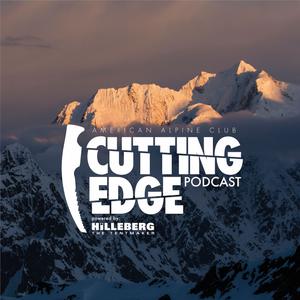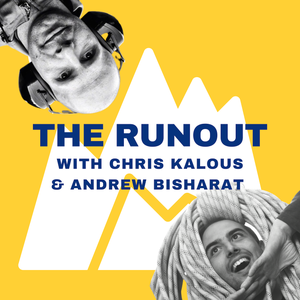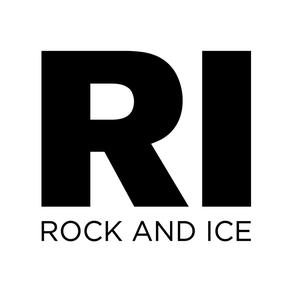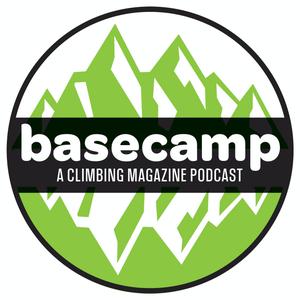
All Things Climbing
BLISTER
The best of the climbing world.
- 29 minutes 4 secondsErik Murdock and Tommy Caldwell on the Natural Resources Management Act
We talk to Tommy Caldwell and Access Fund Policy Director, Erik Murdock, to discuss a massive public lands bill that’s moving through congress called the Natural Resources Management Act. We dive into what makes it so important, hear about Tommy’s involvement with the Access Fund, then Erik helps us unpack the Natural Resources Management Act — what it is, how it was created, and why it matters to climbers.
TOPICS & TIMES:
- Why Tommy got involved with the Access Fund (1:41)
- What’s in the National Resources Management Act? (2:19)
- How did it achieve bipartisan support when so little does? (6:20)
- Which parts have the biggest impact on climbers? (11:24)
- What is the Land and Water Conservation Fund? (13:40)
- Ways for climbers to be better advocates (16:30)
- Other exciting projects with the Access Fund (20:32)
- Plans for Climb the Hill 2019 (22:25)
Hosted on Acast. See acast.com/privacy for more information.
24 February 2019, 4:42 pm - 31 minutes 32 secondsClimbers' Environmental Impact with Author J.B. MacKinnon
What’s the biggest environmental impact we have as climbers? It’s easy to be distracted by the obvious stuff: chalk marks, cat holes, bolts. But, as journalist J.B. MacKinnon points out, the reality is much more complicated.
Longtime climber J.B. Mackinnon is a contributor to The New Yorker on ecology and consumer issues. He has written several award-winning nonfiction books including The 100 Mile Diet and The Once and Future World, and he is now working on a book on consumerism in the outdoor industry. In this conversation, we talk about the places climbing has the greatest environmental impact, how this has changed over the decades, and how we as a community can reduce our footprint.
(MacKinnon's website and work)
TOPICS & TIMES
- MacKinnon’s free soloing experience (1:40)
- What are the biggest environmental issues within climbing culture? (6:25)
- What are the underlying costs of consumer culture? (8:45)
- How is the outdoor industry different from other consumer industries? (10:06)
- What climbing equipment is most problematically produced and marketed? (14:28)
- On the importance of community-wide conversation (18:50)
- How do we decide to leave certain cliffs as ecosystems? (21:25)
- How do we prioritize climbing locally? (23:30)
- How do we get brands to do a better job? (28:20)
Hosted on Acast. See acast.com/privacy for more information.
3 December 2018, 8:33 pm - 59 minutes 12 secondsMaking Homemade Cams: Erick Davidson of Merlin Rock Gear
Erick Davidson makes the best cams that you’ve never heard of — they aren’t sold in stores or online, and Davidson’s company, Merlin Rock Gear, doesn’t even have a website.
Erick, a mechanical engineer by day, designs and fabricates large-format cams that are much larger than Black Diamond’s number 6 Camalot, and that cover sizes way beyond what is protectable with more common commercial cams. And because of some clever engineering and expert construction, they’re also much lighter than the Valley Giant cams that span similar sizes.
Beyond the engineering elements of it all, making your own cams and selling them to people for use in very consequential settings is a much more serious undertaking than making chalk bags, packs, or bouldering pads. So we talk to Erick about the innovations in design he brought to Merlin cams, how he convinced himself that they were safe to use and sell, and where you can pick one up before you find yourself at the base of an unprotectable squeeze chimney.
TOPICS & TIMES
- How did Erick get started making cams? (2:35)
- When cams fail, which part is usually breaking? And why? (9:20)
- What’s different about the stem of Merlin cams? (15:25)
- How does taking tons of poorly placed whippers affect the cam? (22:53)
- What do the control horns do? (32:50)
- Will there be a production run in the future? (39:40)
- Where does the name “Merlin” come from? (47:20)
- How can people place an order? (50:05)
- Has Erick whipped on one of his cams yet? (53:02)
- What’s the best possible way to boost sales? (58:05)
Hosted on Acast. See acast.com/privacy for more information.
19 November 2018, 8:54 pm - 31 minutes 38 secondsPhil Powers and Alex Honnold on a Permit System for The Nose?
Are we headed for a future where The Nose (or other well-traveled walls) are headed for a permit system? We started debating this “what if” scenario almost a year ago, prompted by a conversation about the recently established permit system governing the cables route on Half Dome (the standard “hiking” route to the summit). If crowds grow or rescues become frequent, could certain technical routes, such as The Nose, find themselves governed by a system similar to the one used on Half Dome?
Over the past few months we also put this question to several of our guests to bring in some expert perspectives. So for today’s episode, we’ve got American Alpine Club CEO Phil Powers explaining why he thinks a permit system is likely, and Alex Honnold and Maury Birdwell making the case against. Even after producing this episode, we’re still deliberating, so we’d love to hear your thoughts or opinions and collect more data! Let us know what you think on this episode’s instagram post.
TOPICS & TIMES
- Where did the idea for this question come from? (00:35)
- Phil Powers’ response. (1:35)
- Why would a permit system make more sense for The Nose than other popular climbs? (2:45)
- Two scenarios that could lead the park to instate a permit system. (4:25)
- What might that permit system look like? (9:30)
- Presented by Rhino Skin Solutions (12:00)
- Alex Honnold and Maury Birdwell’s response. (13:50)
- Strengths and weaknesses in their response. (17:25)
- How practical could a permit system be? (21:10)
- What are the potential benefits of a permit system? (24:35)
- Isn’t the rap route another example of adapting to crowding? (25:40)
- What are our conclusions? (26:50)
- Outro (31:25)
PRESENTING SPONSOR: RHINO SKIN SOLUTIONS
Climbing is complex and performing at your limit means bringing many variables together at the right moment. Rhino Skin Solutions makes the best skin care products for keeping your skin dry, healthy, and resilient, which brings one of the most crucial elements of performance under your control. Keeping your skin in good condition not just before a redpoint attempt but throughout the season means more effective training and climbing harder on the wall, it’s as simple as that.
Hosted on Acast. See acast.com/privacy for more information.
29 October 2018, 6:15 pm - 1 hour 12 minutesWhat's it like to climb The Nose?
A couple weeks ago, our host Dave Alie and his wife Katie set off to Yosemite with the goal of climbing The Nose, often called The Greatest Rock Climb on Earth.
It has a reputation as being accessible to non-elite climbers, yet at least half of the teams who leave the ground end up bailing on Day 1.
With the good fortune of a stable forecast, relatively low traffic on the route, and a supportive ground team (helmed by the adventure baby), we succeeded in climbing the route wall-style over three days. Prior to our attempt on The Nose, we had done tons of prep and research, but still had a ton of questions going in.
So this episode is a trip report and our chance to answer many of those questions for folks who might want to give The Nose a go. And if you have any questions that we didn’t cover or you’re gearing up for an attempt and want some beta, feel free to reach out to through Blister at ([email protected]) or on Instagram (@hakunaburrata).
TOPICS & TIMES
- Brought to you by Rhino Skin Solutions (00:40)
- Why Dave and Katie chose to climb in October (4:00)
- How crowded was the route?
- When did they first decide they wanted to climb the Nose?
- Which big walls did they climb in preparation, and why was that so important? (8:50)
- Climbing as a married couple? (23:20)
- How did being new parents affect the experience? (28:45)
- The hazardous ‘Death Block’ at the top of the route (33:32)
- The importance of the order in which you build anchors (37:15)
- Best and worst equipment / food to bring? (40:40)
- Where Dave and Katie passed other teams. (46:20)
- Why The Nose has a misleading reputation for being easy (47:45)
- Dave’s advice to listeners for climbing The Nose? (51:33)
- Lessons from teams who climb in a day and other great resources. (55:00)
- Is there a consensus approach to handling loose rock on classic routes? (1:00:02)
- Outro (1:12:20)
Check out the show notes to this episode to see photos from the route, including the loose block at the Wild Stance.
PRESENTING SPONSOR: RHINO SKIN SOLUTIONS
Climbing is complex and performing at your limit means bringing many variables together at the right moment. Rhino Skin Solutions makes the best skin care products for keeping your skin dry, healthy, and resilient, which brings one of the most crucial elements of performance under your control. Keeping your skin in good condition not just before a redpoint attempt but throughout the season means more effective training and climbing harder on the wall, it’s as simple as that.
Hosted on Acast. See acast.com/privacy for more information.
8 October 2018, 7:26 pm - 56 minutes 20 secondsRhino Skin Solutions founder, Justin Brown
Justin Brown is a Bend, Oregon local who spends much of his free time climbing around the country and volunteering as a board member of the Smith Rock Group. Between campfires and trail-building, he’s even found himself clipping the chains on routes as hard as 5.14a.
He recently ditched his career as a chef to start Rhino Skin Solutions, after elevating his own climbing by creating recipes for some extremely effective antiperspirant and skin-recovery products. We talk about what it has been like to start a business in the outdoor sports industry, why it’s important for us all to give back to the resources we depend on, and why belaying just might be the sport of the future. We also cover why skin care is so important and how it can change your climbing.
TOPICS & TIMES
- Intro (0:00)
- Bivouac Coffee (1:50)
- How did Justin get into climbing? (3:00)
- Why did he end up living in Oregon? (5:25)
- How did Justin’s background as a chef influence his founding Rhino Skin Solutions? (9:20)
- How does Justin make his products? And what is the chemistry behind them? (12:40)
- What level of climber tends to discover the importance of skin care? (23:40)
- Why did Dave initially resist focusing on skin care? And what changed his opinion? (30:25)
- What are some of the best circumstances for using lotion? (34:25)
- What is some of the essential work Justin does with the Smith Rock Group? (37:38)
- How does Justin characterize the climbing at Smith? (42:40)
- Adam Ondra’s skin care. (47:38)
- How can Rhino Skin Solutions serve every type of skin and circumstance? (50:05)
- Will there ever be career belayers, like famous golf caddies? (52:40)
- Outro (55:55)
Hosted on Acast. See acast.com/privacy for more information.
17 September 2018, 9:25 pm - 1 hour 13 secondsMatt Pincus of TrainingBeta
Matt Pincus is a climber’s climber, deeply committed to the sport and the community. He’s also the content manager and head coach / trainer at TrainingBeta, and a Blister alumn. Suffice it to say, when it comes to improving your climbing, the guy knows his stuff. Since the days back when he and I used to trade notes while reviewing gear, he has taken his life on the road, climbing as much as possible and sharing his wisdom and experience with others through coaching sessions and writing. We caught up recently to talk about what he’s learned along the way, how it’s shaped his climbing, and what his perspective is on the trendiness of “training.”
TOPICS & TIMES
- Intro (0:00)
- Bivouac Coffee (1:50)
- How Matt transitioned to being a full-time climber (3:00)
- How do you stay psyched to train? (6:50)
- What's your motivation for climbing hard? (12:20)
- Has the trend in training over-emphasized hang boarding and under-emphasized technique? (15:45)
- What's Matt's own training approach? (24:00)
- What's fun about coaching other people? (29:10)
- Bouldering as movement distilled (36:00)
- Importance of skin maintenance (41:50)
- Quality training instead of over-training (45:30)
- How would you summarize your ideas about training? (48:01)
- What the biggest change happening in climbing? (57:00)
- Outro (59:50)
Presented by Rhino Skin Solutions
Hosted on Acast. See acast.com/privacy for more information.
3 September 2018, 11:07 pm - 1 hour 14 minutesAlex Honnold & Maury Birdwell on the Honnold Foundation and filming Free Solo
Alex Honnold “The Climber” needs absolutely no introduction. He is one of the most talented climbers of his generation, and he is without question the greatest free soloist of all time. And yet, Alex Honnold The Philanthropist” may be even more impressive.
Roughly five years ago, Alex teamed up with Maury Birdwell (an extremely talented climber himself), to start the Honnold Foundation. Since then, they’ve donated countless hours and several hundred thousand dollars (most of it Alex’s money) to support energy access projects in various parts of the developing world. Few climbers have advanced our concept of the sport to the extent that Alex has, yet his more important legacy could be the lives changed by the work of the Honnold Foundation.
In this episode Luke and Dave Alie talk to Alex and Maury about how, exactly, the Foundation works; how they choose their projects; how they gauge whether they’ve been successful; their hopes for the future of the Foundation; and how working in development has changed their perspectives on climbing. And finally, Alex also details what it was like to film the upcoming documentary Free Solo, a film by Chai Vasarhelyi and Jimmy Chin, about his astounding, ropeless ascent of The Freerider on El Cap.
TOPICS & TIMES:
- Intro (00:00)
- Presenting Sponsor: Rhino Skin Solutions (01:50)
- How Alex first got into philanthropy (03:45)
- "Better World Shopping Guide" and conscious consumption (07:30)
- How Maury got involved in the Foundation (13:25)
- Why the Honnold Foundation supports solar projects, specifically (17:30)
- Why form a foundation rather than donate money directly? (20:05)
- Have there been any mistakes in projects? (25:25)
- How they select projects and assess their success (29:20)
- Where do they see the foundation going? (34:40)
- Has their perspective changed on how to best promote renewable energy? (37:45)
- How can people support the foundation? (49:45)
- Does philanthropy make climbing feel small? (51:45)
- What was it like making the film Free Solo? (54:00)
- Did making the film add pressure to complete the climb? (59:10)
- What comes after free soloing El Cap? (1:01:30)
- How is the growth of indoor climbing affecting the sport? (1:05:05)
- What's it like passing people on routes? (1:11:00)
- What's it like being so recognizable? (1:13:25)
- Outro (1:14:25)
Presented by Rhino Skin Solutions
Hosted on Acast. See acast.com/privacy for more information.
13 August 2018, 4:52 pm - 1 hour 1 minuteBolt Restrictions, Hardware Committees, & Threatened Access, Oh My!
As the number of people that are climbing outside continues to explode, there is increasing pressure on land managers and advocacy groups. This often leads either to “active management” (e.g., restrictions on bolts or route development, etc.) or to complete closure. Does this stuff work? Why do we need these types of interventions? How are the ethics and culture of climbing altered or preserved through rules implemented by non-climbers?
Furthermore, this trend is picking up steam all across the US. As just one recent example, a handful of Blister Climbing Editor Dave Alie’s local crags in Golden, Colorado have seen dramatic increases in the number of visitors in recent years, causing the County to step in and take a more active management role. So in this episode, we take a close look at how this practice has impacted climbers through the lens of some high profile Front Range crags. We hear from both Eric Kraus, who oversees outdoor recreation for Jefferson County, and Dave Montgomery, who sits on the Fixed Hardware Review Committee that advises the county on climbing related actions.
TOPICS & TIMES:
Part I - Eric Kraus
- What does Eric do with Jefferson County, and what are their goals? (5:50)
- Which places were instructive to JeffCo when deciding how to manage climbing? (9:30)
- What is the fixed hardware review committee? (11:50)
- Why is it important to have the public sector involved in managing climbing? (13:45)
- What is the process for developing new routes / crags? (15:20)
- Is there oversight for installing / replacing hardware? (21:15)
- Is the useful criticism from the climbing community? (24:35)
- Are we generally headed towards proactive management? (27:00)
- What message would he give to JeffCo land users? (28:40)
Part II - Dave Montgomery
- Dave and Luke’s Introduction. (30:45)
- Why does DM have mixed feelings about the fixed hardware committee? (32:50)
- Do they take into account the different climbing ethics for each crag? (39:20)
- What was Dave's introduction to developing? (42:30)
- What are the advantages of recording who's putting up routes? (45:05)
- What falls under the fixed hardware committee besides climbing? (46:30)
- What would DM personally like to shift in the fixed hardware committee? (53:40)
- What is it like standing between the county and the climbing community? (54:50)
- What can climbers do about raptor closures? (57:40)
Presented by Rhino Skin Solutions
Climbing is complex and performing at your limit means bringing many variables together at the right moment. Rhino Skin Solutions makes the best skin care products for keeping your skin dry, healthy, and resilient, which brings one of the most crucial elements of performance under your control. Keeping your skin in good condition not just before a redpoint attempt but throughout the season means more effective training and climbing harder on the wall, it's as simple as that.
On top of all that, Rhino Skin Founder Justin Brown sits on the board of the Smith Rock Group, which helps plan and fund-raise for various maintenance projects at Smith Rock State Park. We're donating all our proceeds from the show, after production costs, to the American Safe Climbing Associate and the Access Fund. Rhino Skin is fully behind this effort and has offered to knock 10% off your order and kick an additional 10% over to the Access Fund when you use the promo code “Blister” at checkout. Head over to Rhino Skin Solutions to check out their offerings.
Hosted on Acast. See acast.com/privacy for more information.
6 August 2018, 4:51 pm - 43 minutes 35 secondsNik Berry: Trad Climbing's Cutting Edge
Nik Berry has propelled himself onto the national climbing scene with a seemingly unending series of hard sends on long routes all over the country. With a taste for big walls and an aptitude for committing routes, Nik has racked up an impressive list of hard, gear-protected test-pieces including the Salathe Wall (ledge-to-ledge variation) and El Corazon, The Hallucinogen Wall (5.13 R), and El Sendero Luminoso in Wyoming, and the first free ascent of Lunar Ecstasy (5.13 R) in Zion. He has also cultivated a career in nursing and remains one of the most enthusiastic climbers I’ve ever spoken with.
In this episode, Nik discusses how he balances a career with the training required to climb at an elite level; what sort of climbs he aspires to for the rest of his career; and what goes into finding big-wall routes that have potential for free climbing.
TOPICS & TIMES:
- Sending Wet Lycra Nightmare (1:20)
- Dyno into a chicken wing?! Is that actually fun?? (3:36)
- Freeing Lunar Ecstasy (8:33)
- Is there a group-think approach to discovering free-able lines on big walls? (13:55)
- Why aren't there more 5.14 climbs in Zion? (17:50)
- What is it like balancing nursing and climbing? (21:50)
- How do you stay in shape when not climbing? (27:20)
- What about maintaining skin care while not climbing? (29:20)
- What advice would you offer to all beginner climbers? (40:45)
- Would you rather...? (41:55)
- Outro (43:05)
Presented by Rhino Skin Solutions
Hosted on Acast. See acast.com/privacy for more information.
25 June 2018, 10:27 pm - 1 hour 4 minutesBouldering Legend John "Verm" Sherman
Prior to John Sherman’s arrival on the climbing scene back in the time of the Stonemasters, bouldering wasn’t really taken seriously. There was no meaningful, open-ended grading system to compare problems, and Hueco Tanks was just some place in West Texas. John changed all that, and did so before bouldering pads existed.
In the years since casting his long shadow over the sport, John has dedicated himself to wildlife photography, with a particular focus on working to protect the California Condor. He filled me in on how photography and bouldering are linked, what has been lost in climbing since his heyday, and why he thinks there are more impressive feats than Alex Honnold’s free solo of El Cap.
TOPICS & TIMES:
- “Are you chopping lines in the background?” (1:52)
- Episode Introduction (2:05)
- What will you be remembered for most as a climber? (4:40)
- What are you most afraid of being remembered for? (6:30)
- How do you sandbag masterfully? (8:20)
- Do you resent crowding at the crags you developed? (11:05)
- What’s the biggest problem in the sport today? (14:05)
- Is there anything you wish remained with the sport from your heyday? (21:24)
- Does Honnold rehearsing his free solo of The Nose change the accomplishment? (27:15)
- When did you get into photography? (34:21)
- How does wildlife photography compare to bouldering? (36:45)
- Why Condors? (40:30)
- Does your irreverent bent carry over to the photography world? (51:15)
- Is “Old Man Lightning” still going forward? (59:40)
- How can people contribute to Condor recovery? (1:03:05)
- Outro (1:03:52)
Presented by Rhino Skin Solutions
Rhino Skin Solutions makes high-end skin care products for climbers, by climbers. No matter where you climb or how hard, sandstone, granite, limestone, and plastic are all brutal on your skin, and there’s no sense missing a day on the wall because of blisters or splits. And there’s no reason to grease off your project when there are better solutions out there then chalking up every 4 moves. On top of all that, Rhino Skin Founder Justin Brown sits on the board of the Smith Rock Group, which helps plan and fundraise for various maintenance projects at Smith Rock State Park.
We’re donating all our proceeds from the show, after production costs, to the American Safe Climbing Associate and the Access Fund. Rhino Skin is fully behind this effort and has offered to knock 10% off your order and kick an additional 10% over to the Access Fund when you use the promo code “Blister” at checkout.
Hosted on Acast. See acast.com/privacy for more information.
6 June 2018, 4:55 pm - More Episodes? Get the App
Your feedback is valuable to us. Should you encounter any bugs, glitches, lack of functionality or other problems, please email us on [email protected] or join Moon.FM Telegram Group where you can talk directly to the dev team who are happy to answer any queries.
 ClimbSci - Better Climbing Through Science
ClimbSci - Better Climbing Through Science
 The Cutting Edge
The Cutting Edge
 The RunOut Podcast
The RunOut Podcast
 My Epic Podcast
My Epic Podcast
 Basecamp: A Climbing Magazine Podcast
Basecamp: A Climbing Magazine Podcast